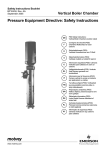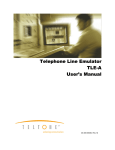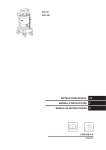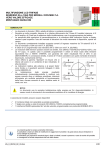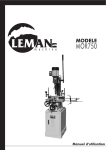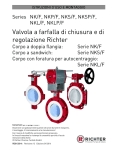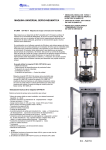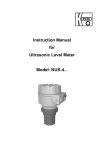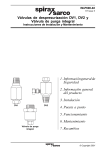Download User Guide - PTFE Lined Piping
Transcript
User Guide A guide to the specification, storage, installation, operation and maintenance of CRP’s range of lined pipes, fittings and ancillary piping products. Sections 1-3 contain practical information for those involved in storage and installation, whilst section 4 is more relevant to those involved in specifying product. An EC declaration of conformity is included in the guide. If you have questions not answered by this guide, CRP will be pleased to help; our contact details can be found at the back of this leaflet. Issue Date: 19/5/10 User Guide - Rev 7 May 10.doc Page 1 of 16 1. Introduction This document is intended to provide information to aid in the specification, storage, installation, operation and maintenance of CRP’s range of lined pipes, fittings and ancillary piping products. While the information contained here is based upon many years of experience, test results and design calculations, it is for general guidance only and is given without guarantee, warranty or liability. In the case of uncertainty on the part of the user, please contact the manufacturer for advice on any of the contents of this document. PTFE, PFA and FEP lined products cannot be treated in the same way as unlined steel products, and personnel responsible for all aspects of them should be competent to undertake such work. 2. Storage 2.1 Generic Instructions Lined products should ideally be stored indoors in cool dry conditions. This is because neither the end boards nor the primer paint with which they are painted, are intended for prolonged outdoor exposure. PTFE and PFA are relatively soft materials. Therefore to protect the lined surfaces they are supplied with end boards. These boards should only be removed immediately prior to installation. If they are removed for inspection purposes they should be replaced immediately or irrevocable damage and distortion may occur. During removal of the end boards care should be taken to avoid damaging the flare faces of the products, since this will likely result in leakage once the item has been installed. During transport, lined products should not be moved by having anything placed inside the bore as an aid to moving, such at the forks of a fork lift truck, since this may well damage the liner, resulting in failure of the lined item. 2.2 Product Specific Instructions 2.2.1 LGSG Level Gauges The LGSG is lined with a PFA liner and is packed in such a way as to protect this liner during transport and storage. This packaging should not be removed until installation as the Issue Date: 19/5/10 User Guide - Rev 7 May 10.doc liner can easily be damaged through the level gauge viewing slots. 2.2.2 Sight Glasses By their very nature, sight glasses contain glass, which is brittle. Care must be taken to avoid impacts with all glass parts of these products during transport and storage. 2.2.3 Dip Legs/Dip Pipes Since these products have an external lining of PTFE, extra care must be taken when storing, handling and transporting them, since, due to their mass, fairly minor drops, knocks, or scrapes can result in the liner being damaged or broken. 3. Installation Operation & Maintenance 3.1 Generic Instructions 3.1.1 Overview PTFE & PFA lined products cannot be treated in the same way as unlined steel products. In order to ensure trouble free operation the following instructions should be followed carefully. Note: Welding, brazing, soldering or flame cutting must not be performed on lined products. These processes may damage the liner and toxic gasses may also be produced. 3.1.2 Flare Faces The flare face on any lined piping component forms the sealing face of the component to the next item in the line. Therefore, it is vital that this face is not damaged at any stage. Particular care should be taken to ensure the following: • • • End boards must be kept in place until immediately prior to installation. Flare faces must be protected during preparation for painting and during painting. When the end boards of an item are removed, the flare faces should be visually inspected. If there is any surface contamination, this should be removed using a soft clean cloth. 3.1.3 System Pressure Testing In deciding upon the appropriate line test pressure, this should be calculated to be 1.5 times the rated pressure of the lowest rated Page 2 of 16 lined piping component in the system, unless some other constraint from another item in the system requires a lower test pressure to be used. In undertaking a pressure test, care should be taken to ensure that pressure is applied from the upstream side of all non-return valves, and is released from the downstream side of all such valves to ensure (a) a pressure test of the complete system and (b) all of the test pressure has been removed from the system at the end of the test. 3.1.4 Gaskets Gaskets are not normally required where PTFE lined items are being connected to similar products. Where components are connecting to dissimilar materials such as glass, ceramic or exotic metal then the use of a PTFE envelope gasket or similar device is recommended. 3.1.5 Vent Holes The majority of lined products contain vent holes (typically 3mm diameter). These holes fulfil two critical purposes: (1) In some circumstances depending on temperature, pressure and the chemistry of the contained media, a small amount of material may permeate through the liner. As it reaches the outside of the PTFE, it can form a trapped gas and if this permeant is not allowed to escape through the vent holes, it can lead to the collapse of the liner in the lined component. (2) To provide an early indication of liner failure. Rather than a liner failure occur catastrophically the vent holes can indicate a problem possibly before it becomes serious. Where vent holes exist, the user is responsible for setting up a system to regularly check them. If any product is leaking from the vent holes, the item in question should be removed from service without delay, since catastrophic failure is likely to occur if no action is taken. It is therefore important not to block the vent holes with paint or any other substance. This requirement applies equally to systems where vent extensions/plugs are utilised. 3.1.6 Bolting Materials Bolting materials should be of good quality, clean and well lubricated. The use of washers is recommended to ensure correct even torque. Bolts should be tightened by use of a torque Issue Date: 19/5/10 User Guide - Rev 7 May 10.doc wrench in strict sequence of diagonally opposite pairs. This, and all subsequent torquing, of bolts should be undertaken at ambient temperature. It is recommended that all bolts are retorqued a minimum of 24 hours after commissioning or following the initial full process cycle. The torque of all bolted joints should then be rechecked at least annually thereafter. The following table gives recommended torque levels for flange to flange connections. Nominal Bore Imp Metric 1" 1.1/2" 2" 3" 4" 6" 8" 10" 12" 25 40 50 80 100 150 200 250 300 Torque Ft Ibs Nm 14 20 35 54 40 80 100 94 107 19 27 47 73 54 108 136 127 145 Qty 4 4 4 4 8 8 8 12 12 Bolts/Studs Size Size (Metric) (UNC) M12 1/2" M12 1/2" M16 5/8" M16 5/8" M16 5/8" M20 3/4" M20 3/4" M24 7/8" M24 7/8" The torque values given above are a guide; they may be exceeded by a value of 50% to effect a seal. If once this torque level has been reached a seal has not been achieved, it is likely that some other source of failure, such as scratched flare faces, is operating. Note: When bolting together dissimilar materials, always tighten to the lowest recommended torque of the components in the joint. Using higher torques may result in damage to the softer material in the joint. 3.1.7 Disassembly The bolts on lined systems must not be loosened while the system temperature is above 60°C otherwise flare distortion or irrevocable damage may occur. Always secure end covers on to the flanges of lined components which have been removed from a system, this will prevent damage, the ingress of dirt and allow trouble free re-assembly. 3.1.8 Stud/Bolt Length Calculator In order to calculate the length of stud/bolt required for any joint, it is necessary to calculate the half joint length for the two flanges that make up the joint, and then add them together. In addition, allowance must be made for any wafer pattern item, such as an instrument tee, that is included in the joint. The information below provides the data necessary to allow these calculations to be made. Page 3 of 16 3.1.8.1 Lined Item Data Size 1" 1 1/2" 2" 3" 4" 1" 1 1/2" 2" 3" 4" 6" 8" 10" 12" 8" 10" 12" 1" 1 1/2" 2" 3" 4" 6" 8" 10" 12" 8" 10" 12" 1" 1 1/2" 2" 3" 4" 6" 8" 10" 12" 1" 1 1/2" 2" 3" 4" 6" 1" 1 1/2" 2" 3" 4" 6" 8" 10" 12" 1" 1 1/2" 2" 3" 4" 6" 1" 1 1/2" 2" 3" 4" 6" Component Vanstone Spool Vanstone Spool Vanstone Spool Vanstone Spool Vanstone Spool Standard Spool Fixed Flange Standard Spool Fixed Flange Standard Spool Fixed Flange Standard Spool Fixed Flange Standard Spool Fixed Flange Standard Spool Fixed Flange Standard Duty Spool Fixed Flange Standard Duty Spool Fixed Flange Standard Duty Spool Fixed Flange Heavy Duty Spool Fixed Flange Heavy Duty Spool Fixed Flange Heavy Duty Spool Fixed Flange Standard Spool Rotating Flange Standard Spool Rotating Flange Standard Spool Rotating Flange Standard Spool Rotating Flange Standard Spool Rotating Flange Standard Spool Rotating Flange Standard Duty Spool Rotating Flange Standard Duty Spool Rotating Flange Standard Duty Spool Rotating Flange Heavy Duty Spool Rotating Flange Heavy Duty Spool Rotating Flange Heavy Duty Spool Rotating Flange Fitting Fixed Flange Fitting Fixed Flange Fitting Fixed Flange Fitting Fixed Flange Fitting Fixed Flange Fitting Fixed Flange Fitting Fixed Flange Fitting Fixed Flange Fitting Fixed Flange Fitting Rotating Flange Fitting Rotating Flange Fitting Rotating Flange Fitting Rotating Flange Fitting Rotating Flange Fitting Rotating Flange 45 degree Elbow Fixed Flanges(1) 45 degree Elbow Fixed Flanges 45 degree Elbow Fixed Flanges 45 degree Elbow Fixed Flanges 45 degree Elbow Fixed Flanges 45 degree Elbow Fixed Flanges 45 degree Elbow Fixed Flanges 45 degree Elbow Fixed Flanges 45 degree Elbow Fixed Flanges 45 degree Elbow Rotating/Fixed 45 degree Elbow Rotating/Fixed 45 degree Elbow Rotating/Fixed 45 degree Elbow Rotating/Fixed 45 degree Elbow Rotating/Fixed 45 degree Elbow Rotating/Fixed 45 degree Elbow Rotating Flanges(1) 45 degree Elbow Rotating Flanges(1) 45 degree Elbow Rotating Flanges(2) 45 degree Elbow Rotating Flanges(2) 45 degree Elbow Rotating Flanges 45 degree Elbow Rotating Flanges Issue Date: 19/5/10 User Guide - Rev 7 May 10.doc Flange Thickness 15.0 18.0 20.0 24.0 24.0 15.0 18.0 19.0 24.0 24.0 26.0 29.0 31.0 32.0 29.0 31.0 32.0 15.0 18.0 19.0 24.0 24.0 26.0 29.0 31.0 32.0 29.0 31.0 32.0 15.0 18.0 19.0 24.0 24.0 26.0 29.0 31.0 32.0 15.0 18.0 19.0 24.0 24.0 26.0 15.0 18.0 19.0 24.0 24.0 26.0 29.0 31.0 32.0 15.0 18.0 19.0 24.0 24.0 26.0 15.0 18.0 19.0 24.0 24.0 26.0 Steel Flare/Stub End Thickness 3.0 3.0 3.0 3.0 5.0 12.0 12.0 14.0 16.0 16.0 18.0 20.0 22.0 22.0 20.0 22.0 22.0 12.0 12.0 14.0 16.0 16.0 18.0 6.0 12.0 14.0 16.0 16.0 18.0 6.0 7.0 7.0 8.0 16.0 18.0 Liner Thickness/ Upstand 2.5 2.5 2.5 2.5 4.0 2.5 2.5 2.5 2.5 4.0 5.0 4.0 4.0 5.0 6.0 7.0 8.0 2.5 2.5 2.5 2.5 4.0 5.0 4.0 4.0 5.0 6.0 7.0 8.0 4.5 5.0 5.5 6.0 7.0 7.5 9.5 11.0 11.0 4.5 5.0 5.5 6.0 7.0 7.5 2.5 2.5 2.5 2.5 4.0 5.0 9.5 11.0 11.0 2.5 2.5 2.5 2.5 4.0 5.0 2.5 2.5 2.5 2.5 4.0 5.0 Half Joint Total Thickness 20.5 23.5 25.5 29.5 33.0 17.5 20.5 21.5 26.5 28.0 31.0 33.0 35.0 37.0 35.0 38.0 40.0 29.5 32.5 35.5 42.5 44.0 49.0 53.0 57.0 59.0 55.0 60.0 62.0 19.5 23.0 24.5 30.0 31.0 33.5 38.5 42.0 43.0 31.5 35.0 38.5 46.0 47.0 51.5 17.5 20.5 21.5 26.5 28.0 31.0 38.5 42.0 43.0 23.5 32.5 35.5 42.5 44.0 49.0 23.5 27.5 28.5 34.5 44.0 49.0 Notes (1) Bolt holes threaded 1/2" UNC (2) Bolt holes threaded 5/8" UNC Page 4 of 16 3.1.8.2 Nut/Stud Data UNC Thread Thread Pitch (mm) 3.1.8.3 Wafer Pattern Component Data Nut Thickness* (mm) Ordinary Heavy 1/2" 2 11 13 5/8" 2.3 14 16 3/4" 2.5 17 19 7/8" 2.8 19 23 Metric Thread Thread Pitch (mm) Nut Thickness (mm) M12 1.75 10 M16 2 13 M20 2.5 16 M24 3 19 * Assuming nuts are faced on one side Example To work out the length of a stud for a joint add together the total length for each half of the joint. e.g. a 1.1/2" fitting to a 1.1/2" rotating flange spool = 23mm + 32.5mm = 55.5mm. To this value add on two off nut thicknesses + clear threads if using studs or one nut thickness + clear threads if using bolts. 3.2 Product Specific Instructions If there is no mention of a particular product in this section, there are no additional product specific instructions to follow. 3.2.1 CTSG/DTSG/BFSG Following installation the tie rod torques must be checked. This is achieved in the following manner: • • Release the backing nuts at both end of the sight glass. Check the torques on the outer tie rod nuts with a torque wrench in pairs diagonally opposite – see the table below for recommended torques. Nb. This is a safety critical step. Failure to retighten the tie rods may lead to leakage between the end flanges and the glass. Retighten all of the backing nuts. NB. This is a safety critical step. Failure to retighten these nuts may lead to excessive compressive or torsional loads being applied to the glass, resulting in damage to, or failure of, the glass. Issue Date: 19/5/10 User Guide - Rev 7 May 10.doc Size 1/2" Branch 3/4" Branch 1" Branch 1 1/2" Branch 2" Branch 3" Branch 1/2" 1" 1 1/2" 2" 3" 4" 1/2" 1" 1.1/2" 2" 3" 4" 6" 8" 10" 12" 4" 6" 8" 10" 12" Component Instrument Tee Instrument Tee Instrument Tee Instrument Tee Instrument Tee Instrument Tee WPCV WPCV WPCV WPCV WPCV WPCV CTSG/DTSG CTSG/DTSG CTSG/DTSG CTSG/DTSG CTSG/DTSG CTSG/DTSG CTSG/DTSG CTSG/DTSG CTSG/DTSG CTSG/DTSG STCV STCV STCV STCV STCV Component Thickness 51.0 51.0 51.0 76.0 89.0 150.0 30.0 35.0 45.0 56.0 71.0 80.0 34.0 38.0 38.0 38.0 43.0 46.0 46.0 45.0 49.0 52.0 52.0 56.0 60.0 68.0 78.0 The following table gives recommended torque levels for tie rod nuts. Nominal Bore Imp Metric 1" 25 1.1/2" 40 2" 50 3" 80 4" 100 6" 150 8" 200 10” 250 12” 300 Torque Ft lbs Nm 7.5 10 11 15 14.5 20 22 30 28 37 32 44 32 44 32 44 32 44 It is recommended that tie rod torques are checked at least 24 hours after commissioning or following the initial full process cycle, and at least annually thereafter. 3.2.2 LGSG The LGSG is lined with a PFA liner and is adequately protected in transit. This packing must not be removed until installation as the liner can easily be damaged through the level gauge viewing slots. Page 5 of 16 3.2.3 WPCV & FPCV (Wafer & Flanged Poppet Check Valve) In addition to the generic installation instructions for lined pipe products; • Check that the direction of flow arrow on the valve body points in the right direction. • Ensure that the mounting flanges are parallel. • Position the valve centrally between flange faces. • Ensure that there is sufficient contact between the flange faces and the sealing area of the check valve. 3.2.4 SPCV (Sight Glass Poppet Check Valve) Follow generic installation instructions for lined pipe products and the additional instructions above for CTSG/DTSG/BFSG products. Also, particular care must be taken to ensure the product is installed the correct way up vis-à-vis flow direction. 3.2.5 Dip Legs & Dip Pipes The Dip Pipe is externally lined and great care must be taken when handling this product to ensure that the liner is not damaged during transport, storage or installation. 3.2.6 Tee Piece & Bullseye Sight Glasses Following installation the tie rod torques must be checked with a torque wrench in pairs diagonally opposite. The following table gives recommended torque levels for tie rod nuts. Nominal Bore Imp Metric 1" 25 1.1/2" 40 2" 50 3" 80 4" 100 6" 150 No. of Tie Rods 4 4 4 4 6 8 Torque Ft lbs Nm 11 15 18 24 31 42 44 59 51 69 39 53 It is recommended that tie rod torques are checked at least 24 hours after commissioning or following the initial full process cycle, and at least annually thereafter. 4. User Instructions 4.1 Generic User Instructions (1) It is the responsibility of the user to ensure that the products are suitable for conveying the intended chemical(s) and Issue Date: 19/5/10 User Guide - Rev 7 May 10.doc 3.2.7 STCV The valve can be universally mounted in both horizontal and vertical pipelines and some angled pipelines. The angled sealing face is particularly beneficial in horizontal lines in providing a positive shutoff, as even when the disc is closed against the seat; gravity still exerts a noticeable closing force on the disc. In horizontal lines the valve must be mounted correctly with the hinge part of the valve uppermost within the pipeline. In vertical or angled lines the flow must be upward through the valve allowing gravity to provide a valve closing force. The valve body has a clear flow direction arrow cast into the side. The valve must be fitted into the pipeline with the direction of this arrow pointing downstream. The 8in (DN200) and above sized valves have a threaded hole in the top of the body to allow a lifting eye to be fitted to allow easy handling and installation. The valve is manufactured to selfcentre between the boltholes. Typically for instance in a horizontal line, the two adjacent bottom bolts would be fitted first and the swing check valve rested on these bolts. Then the remaining bolts can be fitted and all bolts correctly tightened to the specified torque. There are no user serviceable items in the product; although it is recommended that for critical services the valve should be inspected for wear at an interval to be determined by the user according to the severity of the duty. 3.2.8 Bellows For guidance on the selection, installation and use of bellows, please refer to the Bellows User Instructions & Technical Guide on the website. 3.2.9 Atomac and Durco Valve Products Please refer to the appropriate Installation, Operation and Maintenance Manuals on the website. for the intended operating conditions. Specifically, consideration must be given to the effects of corrosion, erosion/wear, including potential effects from turbulence and vortices etc. It should be noted that while PTFE/PFA/FEP have outstanding Page 6 of 16 corrosion resistance, they have limited erosion resistance, and contained fluid velocities should be kept below 15m/s. In addition, these products are not approved for conveying unstable fluids. (2) (3) Solids or slurry handling can create erosion in addition to corrosion. The following list provides general guidance on the handling of slurries. However the degree of erosion is dependent on the nature of the solids being handled, and therefore in cases of doubt, it is recommended that testing be carried out to prove the suitability of lined piping. • The contained fluid and solids should be chemically compatible with the lining. • Ideally, the flow velocity should be kept at 0.6 to 1.2 m/sec but in any case should not be more than 2.1 m/sec. Consideration must be given to components where the flow path is convoluted, since this may give rise to local flow velocities in excess of the general flow velocity. • To minimize erosion, particle sizes should be less than 60 microns. Particle sizes greater than 150 microns will likely result in unacceptable levels of erosion. Intermediate particle sizes will likely result in acceptable levels of erosion. • Long radius elbows should be used. • Regular inspections of the insides of the lined piping system should be conducted to ensure that no excessive erosion has occurred. In designing the support structure the user must take into account the following factors in both operating and test conditions, and the possibility of more than one of these loads occurring simultaneously: • Internal pressure from the contained fluid. • The mass of the contained fluid. • Traffic wind and earthquake loading. • The potential to overstress the flanges. • Vibration. • Reaction forces and moments which result from the supports, attachments, thermal movement, other piping etc. • Fatigue etc. Issue Date: 19/5/10 User Guide - Rev 7 May 10.doc (4) In earthquake conditions, CRP is unable to guarantee the integrity of its products, and the user must take suitable precautions to guard against potential product failure and its consequences in these circumstances. (5) It is the responsibility of the user to ensure that suitable pressure relief and other appropriate safety devices have been included in the design of the entire pressure system, and that discharges from such equipment have been considered, including draining facilities to prevent liquid build up in gas lines which may give rise to water hammer. (6) If the products are to reach temperatures during operation or test which would be harmful to individuals, should they come in contact with the products in these conditions, it is the user’s responsibility to overcome this hazard. (7) The user is responsible for ensuring that suitable provision is made to allow for any necessary draining and venting of the system. (8) The user is responsible for ensuring that suitable provision is made to allow for isolation of take off pipes if these are of a size to present a significant risk. In addition, the risk of inadvertent discharge must be minimised, the take off points must be clearly marked on the permanent side, indicating the fluid contained. (9) While CRP apply a corrosion resistant undercoat/paint to products, or other customer specific paint, prior to despatch, unless specifically instructed not to do so by the customer, or it is unnecessary due to the materials of construction, the user is responsible for the maintenance of the exterior of the products to prevent corrosive attack. (10) Where, under reasonably foreseeable conditions, the allowable pressure limits of the products could be exceeded, the user is responsible for the fitting of suitable protective devices, and, if appropriate adequate monitoring devices. (11) By their nature, PTFE/PFA/FEP lined products are not fire proof (the PTFE/PFA/FEP lining will melt under extremes of heat). Also, the integrity of the glass elements of sight glasses cannot be guaranteed under such conditions. Therefore, if appropriate, the user must consider how to meet any damage Page 7 of 16 limitation requirements in the event of a fire. (12) If lined pipes or other products are to be placed underground, it is recommended that, as a minimum, their position and route be recorded in the technical documentation to facilitate safe maintenance, inspection and repair. (13) If lined equipment is to be used to for wet chlorine duty, the maximum temperature must not exceed 150°C. Above this temperature, any chlorine that permeates the liner may react with the steel shell, and cause a fire. 4.2 spools/fittings. In most cases the flanges are the limiting factor (see tables below). Nb. Pressures are shown in bar(g). For pressure ratings at intermediate temperatures in the tables below, linear interpolation can be used to calculate allowable pressures. Product Specific User Instructions 4.2.1 ½” NB – 12” NB Spools & Lined Fittings Maximum and Minimum Allowable Operating Pressures and Temperatures These are determined by the lowest of the allowable limits for the items comprising the Flange Class ASME B16.5, Class 150 ASME B16.5, Class 300 BS EN 1092-1 PN10 BS EN 1092- 1 PN16 Temp (°C) -29 to 38 93 149 200 -29 to 38 93 149 200 -10 to 50 100 150 200 -10 to 50 100 150 200 Flange Class BS10 Table D BS10 Table E ISO1609 1 19.7 17.9 15.9 13.8 31.0 27.8 23.7 20.0 10.0 10.0 9.7 9.4 16.0 16.0 15.6 15.1 Temp (°C) -17.8 - 200 -17.8 - 200 -29 - 200 2 19.0 15.9 14.1 13.1 31.0 27.8 23.7 20.0 9.1 7.5 6.8 6.3 14.7 12.1 11.0 10.2 Flange Material Type 3 4 5 19.0 15.9 16.2 13.4 14.8 12.1 13.4 11.0 31.0 31.0 27.8 27.8 23.7 23.7 20.0 20.0 9.1 7.6 10.0 7.8 6.3 8.0 7.1 5.7 7.5 6.6 5.3 6.9 14.7 12.3 16.0 12.1 10.2 12.8 11.0 9.2 11.9 10.2 8.5 11.0 Minimum Pressure -1 Maximum Pressure 6.9 13.8 1.5 However, in a few cases, the pipe can be the limiting factor. The table below shows the situations where this may be the case. If the pipe doesn’t appear, then this means that it can never be the pressure limiting factor for the spool/fitting. Nb. The pressures shown here (given in bar(g)) are applicable across the entire operating temperature range. 6 17.2 16.2 14.8 13.8 7 18.3 17.2 15.9 13.8 31.0 27.8 23.7 20.0 Pipe NB 6 8 10 12 12 Flange Material Types: 1. 2. 3. 4. 5. 6. 7. ASTM A105, ASTM A350 Grade LF2, ASTM A216 Grade WCB ASTM A182 Grade F304 ASTM Grade F316 ASTM A182 Grades F304L and F316L DIN 17100 R.St 37.2 ASTM A395 BS1501-161 Grade 430A Pipe Schedule 10 10 10 10 20 Material (All to ASTM A312) TP304 TP304L TP316 TP316L 27.64 23.45 20.98 19.29 N/a 23.50 19.94 17.83 16.41 27.83 28.71 24.35 21.79 20.04 27.83 30.22 19.45 17.39 16.00 22.22 The vacuum performance of spools and fittings are as detailed below: Product Size Range Spools Spools Fittings Fittings 1/2” – 8” NB 10” & 12” NB (heavy duty liner) 1/2” – 6” NB 8” – 12” NB Issue Date: 19/5/10 User Guide - Rev 7 May 10.doc Temperature Range full vacuum -29°C to +200°C full vacuum -29°C to +150°C full vacuum -29°C to +200°C consult factory Rating Page 8 of 16 4.2.2 Spacers – Types 1, 2, & 3 Maximum and Minimum Allowable Operating Pressures and Temperatures These are determined by the lowest of the allowable limits for the adjacent components. (See tables below). Flange Class ASME B16.5, Class 150 ASME B16.5, Class 300 BS EN 1092-1 PN10 BS EN 1092-1 PN16 BS10 Table D BS10 Table E ISO1609 Temp (°C) -29 to 38 93 149 200 -29 to 38 93 149 200 -10 to +50 100 150 200 -10 to +50 100 150 200 -17.8 to 200 -17.8 to 200 -29 - 200 Maximum Pressure 19.7 17.9 15.9 13.8 31.0 27.8 23.7 20.0 10.0 10.0 9.7 9.4 16.0 16.0 15.6 15.1 6.9 13.8 1.5 NB. 1. Type 1 spacers are unsuitable for pressures greater than those of ASME B16.5 Class 150. 2. Pressures are shown in bar(g). 4.2.3 CTSG, DTSG and BFSG Tubular Sight Glasses In assessing the suitability of a CTSG/DTSG/BFSG for a particular service duty, it should be noted that the tubular elements of these sight glasses are made from borosilicate glass 3.3 to ISO 3585, and the user must confirm the fitness of this glass for conveying the intended chemicals. Further, if an unlined tubular sight glass is being used, the user must ensure the compatibility of the contained fluid with the flange material. These products are unsuitable for resisting torsional loads and the support system should ensure that these are not applied. Maximum and Minimum Allowable Operating Pressures and Temperatures In all cases, these products can withstand full vacuum across their entire operating temperature range. The one exception to this is if a PFA/FEP liner has been added to the inside of the glass, in which case the sight glass is not suitable for vacuum pressures. The maximum allowable operating pressures are determined by the lowest of the allowable limits for the items comprising the sight glasses. In most cases the glass is the limiting factor (see the table below – data is for all temperatures from –29°C to 150°C. Pressures are shown in bar(g). Issue Date: 19/5/10 User Guide - Rev 7 May 10.doc Glass Tube NB ½” ¾” 1” 1½” 2” 2½” 3” 4” 5” 6” 8” 10” 12” Maximum Pressure 10 10 10 10 10 10 10 10 10 6 5 3 3 However, in a few cases, the flanges can be the limiting factor. The tables below show the situations where this may be the case. If the flange doesn’t appear, then this means that it can never be the pressure limiting factor for the sight glass. NB The pressures shown here (given in bar(g)) are applicable across the entire operating temperature range. Page 9 of 16 Flange Material Type 1 2 3 4 5 10.0 9.1 9.1 7.6 10.0 10.0 7.5 7.8 6.3 9.3 9.7 6.8 7.1 5.7 8.7 Maximum Pressure Flange Class BS EN 1092-1 PN10 Temp (°C) -10 to 50 100 150 BS10 Table D -17.8 to 200 6.9 Flange Material Types 1. BS1501-161-430 4.2.4 LGSG Tubular Sight Glasses These products are unsuitable for resisting torsional loads and the support system should ensure that these are not applied. Maximum and Minimum Allowable Operating Pressures and Temperatures These are determined by the lowest of the allowable limits for the items comprising the sight glasses. In most cases the PFA lining is the limiting factor (see the graph below). Recommended Maximum Internal Pressure (bar) However, in a few cases, the flanges can be the limiting factor. The tables below show the situations where this may be the case. If the flange doesn’t appear, then this means that it can never be the pressure limiting factor for the sight glass. Flange Class BS EN 1092-1 PN10 Temp (°C) -10 to 50 100 150 BS10 Table D -17.8 to 200 Flange Material Type 1 2 3 4 5 6 10.0 10.0 10.0 10.0 9.1 9.1 10.3 9.3 8.0 9.3 7.5 7.8 9.7 8.7 7.5 8.7 6.8 7.1 Maximum Pressure 7 7.6 6.3 5.7 6.9 Flange Material Types 1. ASTM A105, ASTM A350 Gr. LF2, ASTM A216 Gr. WCB 2. BS1501-161-430 3. DIN 17100 R.St 37.2 4. DIN 2528 C22.8 5. ASTM A182 Gr. F304 6. ASTM A182 Gr. F316 7. ASTM A182 Gr. F304L, F316L 12 Pressure: bar(g ) 2. ASTM A216 Grade WCB 3. ASTM A240 Gr. 304, BS970:1991 Gr. 304S15, 230M07, 070M20 4. ASTM A240 Gr. 316, BS970:1991 Gr. 316S31 5. ASTM A240 Gr. 304L, 316L, BS970:1991 Gr. 304S11, 316S11 Further with the BFSG Range of products, the floating ball is the limiting pressure factor. With all sizes of BFSG, the pressure is limited to 4bar(g) across the entire temperature range. 10 8 6 4 2 0 0 25 50 75 100 125 150 175 Temperature (C) 4.2.5 WPCV, FPCV and SPCV Poppet Check Valves When considering draining and venting of systems containing check valves, consideration must be given to the non-return flow characteristics of the valves. In assessing the suitability of SPCV valves, for a particular service duty consideration must be given to the corrosion and erosion resistance of the borosilicate glass used in the sight glass element of the valves. These are made from borosilicate glass 3.3 to ISO 3585. Issue Date: 19/5/10 User Guide - Rev 7 May 10.doc Maximum and Minimum Allowable Operating Pressures and Temperatures. In all cases, these products can withstand full vacuum across their entire operating temperature range. Their maximum operating pressures are as detailed below: WPCV SPCV Temperature range: Pressure range: Temperature range: Pressure range: -29°C to +200°C. -1 to 19.7 bar(g). -29°C to +150°C. -1 to 10.0 bar(g). Page 10 of 16 FPCV: See tables below for details of the allowable pressure and temperature ranges for these valves. These are determined by the lowest of the allowable limits for the flanges on Flange Class ASME B16.5, Class 150 BS EN 1092-1 PN10 BS EN 1092- 1 PN16 Temp (°C) -29 to 38 93 149 200 -10 to 50 100 150 200 -10 to 50 100 150 200 BS10 Table D -17.8 to 200 BS10 Table E -17.8 to 200 4.2.6 Flange Material Type 1 2 3 4 5 19.7 19.0 19.0 15.9 17.9 15.9 16.2 13.4 15.9 14.1 14.8 12.1 13.8 13.1 13.4 11.0 10.0 9.1 9.1 7.6 10.0 10.0 7.5 7.8 6.3 8.0 9.7 6.8 7.1 5.7 7.5 9.4 6.3 6.6 5.3 6.9 16.0 14.7 14.7 12.3 16.0 16.0 12.1 12.5 10.2 12.8 15.6 11.0 11.4 9.2 11.9 15.1 10.2 10.6 8.5 11.0 Maximum Pressure 6.9 13.8 Dip Legs and Dip Pipes Maximum and Minimum Allowable Operating Pressures and Temperatures. In all cases, these products can withstand full vacuum across their entire operating temperature range. Their maximum operating pressures are determined by the lowest of the allowable limits for the items comprising the dip legs/pipes. In most cases the flanges are the limiting factor (see tables below). NB Pressures are shown in bar(g). Flange Class ASME B16.5, Class 150 ASME B16.5, Class 300 BS EN 1092-1 PN10 BS EN 1092- 1 PN16 Temp (°C) -29 to 38 93 149 200 -29 to 38 93 149 200 -10 to 50 100 150 200 -10 to 50 100 150 200 BS10 Table D -17.8 to 200 BS10 Table E -17.8 to 200 Flange Material Type 1 2 3 4 19.7 19.0 19.0 15.9 17.9 15.9 16.2 13.4 15.9 14.1 14.8 12.1 13.8 13.1 13.4 11.0 31.0 31.0 31.0 31.0 27.8 27.8 27.8 27.8 23.7 23.7 23.7 23.7 20.0 20.0 20.0 20.0 10.0 9.1 9.1 7.6 10.0 7.5 7.8 6.3 9.7 6.8 7.1 5.7 9.4 6.3 6.6 5.3 16.0 14.7 14.7 12.3 16.0 12.1 12.5 10.2 15.6 11.0 11.4 9.2 15.1 10.2 10.6 8.5 Maximum Pressure 6.9 13.8 Issue Date: 19/5/10 User Guide - Rev 7 May 10.doc 5 18.3 17.2 15.9 13.8 31.0 27.8 23.7 20.0 10.0 9.3 8.7 7.8 16.0 14.9 13.9 12.4 the ends of the valves. Nb. Pressures are in bar(g). 6 18.3 17.2 15.9 13.8 10.0 9.3 8.7 7.8 16.0 14.9 13.9 12.4 Flange Material Types 1. ASTM A105, ASTM A350 Grade LF2, ASTM A216 Grade WCB 2. ASTM A182 Grade F304 3. ASTM Grade F316 4. ASTM A182 Grades F304L and F316L 5. DIN 17100 R.St 37.2 6. BS1501-161 Grade 430A Flange Material Types 1. ASTM A105, ASTM A350 Grade LF2, ASTM A216 Grade WCB 2. ASTM A182 Grade F304, ASTM A240 Grade 304 3. ASTM Grade F316, ASTM A240 Grade 316 4. ASTM A182 Grades F304L and F316L, ASTM A240 Grades 304L and 316L 5. BS1501-161 Grade 430A Adapter Flanges Adapter Max. pressure Flange (bar(g) 400x25 25.0 400x40 25.5 400x50 26.0 400x80 27.0 400x100 29.0 NB While every effort is made to ensure that the products supplied are to specification, the user should note that it is impossible to pressure test dip leg/pipes and, therefore, as part of plant commissioning such a test should be undertaken. Page 11 of 16 4.2.7 Blanking Spades, Lined Spectacle Blinds and Solid PTFE Spectacle Blinds Maximum and Minimum Allowable Operating Pressures and Temperatures In all cases, these products can withstand full vacuum across their entire operating temperature range. Their maximum operating pressures are as detailed below: Maximum Pressures (bar(g)) Blanking Spades DN -29°C to 149°C 150°C to 200°C 31 31 31 31 24 11 6.3 2.8 1.6 1.0 0.68 0.57 0.43 31 31 31 31 22 10 5.9 2.6 1.5 0.93 0.64 0.54 0.41 15 20 25 40 50 80 100 150 200 250 300 350 400 PTFE/PFA Lined Solid PTFE Spectacle Blinds Steel Spectacle 23°C 100°C 200°C Blinds 31.0 31 31 24 31.0 31 31 24 31.0 31 27 15 31.0 25 11 6.4 31.0 31 18 10 31.0 18 8.1 4.5 30.6 29 13 7.4 31.0 13 5.9 3.3 31.0 7.3 3.3 1.8 31.0 N/A N/A N/A 31.0 N/A N/A N/A N/A N/A N/A N/A N/A N/A N/A N/A 4.2.8 Tee Piece and Bulls Eye Sight Glasses In assessing the suitability of tee piece and bulls eye sight glasses, for a particular service duty it should be noted that the glass elements of these sight glasses are made from borosilicate glass to DIN 7080, and, if the glass is unlined, the user must confirm the suitability of this glass for conveying the intended chemicals. Maximum and Minimum Allowable Operating Pressures and Temperatures. In all cases, these products can withstand full vacuum across their entire operating temperature range. Their maximum operating pressures are determined by the lowest of the allowable limits for the flanges on the sight glasses and are as detailed below. NB. All pressures are shown in bar(g). NB 1. For PTFE/PFA lined items, the operating temperature range is –29°C to 200°C. For FEP lined items the range is –29°C to 150°C. 2. For solid PTFE spectacle blinds the limits are for blinds of the thicknesses detailed below. For other thicknesses contact CRP for details of pressure limits. 3. All pressures are shown in bar(g). DN Thickness DN Thickness DN Thickness 15 20 25 10 10 10 40 50 80 10 16 16 100 150 200 27 27 27 Fabricated Sight Glasses Flange Class ASME B16.5, Class 150 Temp (°C) -29 to 38 93 149 200 -10 to 50 100 150 200 -10 to 50 100 150 200 Flange Material Type 1 2 3 19.7 18.3 17.9 17.2 15.9 15.9 13.8 13.8 10.0 10.0 10.0 BS EN 10.0 9.3 8.0 1092-1 9.7 8.7 7.5 PN10 9.4 7.8 6.9 16.0 16.0 16.0 BS EN 16.0 14.9 12.8 1092- 1 15.6 13.9 11.9 PN16 15.1 12.4 11.0 Maximum Pressure BS10 Table D -17.8 to 200 6.9 BS10 Table E -17.8 to 200 13.8 Flange Material Types: 1. ASTM A105, ASTM A350 Grade LF2, ASTM A216 Grade WCB 2. BS 1501-16-430, DIN 2528 C22.8 3. DIN 17100 R.St 37.2 Cast Sight Glasses Temp (°C) Min -29 to 38 93 149 200 -1 -1 -1 -1 Operating Pressures (Bar(g)) Max Max ASTM A395 ASTM A216 WCB 17.2 19.7 16.2 17.9 14.8 15.9 13.8 13.8 Issue Date: 19/5/10 User Guide - Rev 7 May 10.doc The glass discs on sight glasses must never be loosened or removed when the internal pressure in the sight glass is other than ambient, nor when there is a contained fluid present whose leakage would be hazardous to personnel or equipment. Page 12 of 16 4.2.9 STCV Swing Check Valves When considering draining and venting of systems containing check valves, consideration must be given to the non-return flow characteristics of the valves. Maximum and Minimum Allowable Operating Pressures and Temperatures STCV: Temperature range: -29°C to +200°C. Pressure range: -1 to 19.7 bar(g). Issue Date: 19/5/10 User Guide - Rev 7 May 10.doc For these valves the maximum operating pressure is limited to that of an ASME B16.5 Class 150 flanged component of the same material, as detailed in the table below – pressures are shown in bar(g). Temperature (°C) -29 – 38 93 149 200 Valve Material ASTM A216 Gr. ASTM A351 WCB Gr. CF8M 19.7 19.0 17.9 16.2 15.9 14.8 13.8 13.4 Page 13 of 16 EC Declaration of Conformity I hereby declare that the products listed below, comply with the requirements of the relevant sections of the Pressure Equipment Regulations 1999 / Pressure Equipment Directive 97/23/EC. Manufactured by: CRP Ltd, Todmorden Road, Littleborough, OL15 9EG, UK. Assessed by the notified body: HSB Inspection Quality Limited, Cairo House, Greenacres Road, Waterhead, Oldham, Lancashire, OL4 3JA, UK. Assessed against the requirements of the Conformity Assessment Procedure: Module H1 Designed & manufactured to meet the appropriate requirements of the following standards as relevant: API 5L. ASME Boiler and Pressure Vessel Code, Part IX. ASME B16.10. ASME B16.42. ASME B16.5. ASME B16.9. ASME B31.3. ASME B36.10. ASME B36.19. ASTM A105. ASTM A106. ASTM A182. ASTM A216. ASTM A234. ASTM A240. ASTM A269. ASTM A312. ASTM A333. ASTM A350. ASTM A351. ASTM A395. ASTM A587. ASTM D1457. ASTM D2116. ASTM D3307. ASTM F1545. ASTM F423. BS 10. BS 1501-1. BS 1560. BS 287. BS 288. BS 4360 BS 5500. BS 6564-3 (1990). BS 970:1991. BS EN 1092-1. BS EN ISO 1595:1997. DIN 11851. DIN 1626. DIN 1629. DIN 2528. DIN 2605. DIN 2615. DIN 2616. DIN 2848. EN 10025 (DIN 17100). ISO 1609. ISO 3585. ISO 9000. SMS 1145. SMS 1146. Product Range: Description PTFE Lined Pipe Spools: CTSG & DTSG Tubular Sight Glasses BFSG Tubular Sight Glasses FEP Lined Dip Pipes/Dip Legs PTFE Lined Dip Pipes/Dip Legs LGSG Tubular Sight Glasses PTFE/PFA Lined Elbows (all angles up to 180°) PFA Lined Tees (equal and reducing) PFA Lined Lateral Tees (equal and reducing) PFA Lined Instrument Tees PFA Lined Short Stack Tees PFA Lined Crosses (equal and reducing) PTFE/PFA Lined Concentric & Eccentric Reducers PTFE/PFA Lined Reducing Flanges PTFE/PFA Lined Blank Flanges WPCV, FPCV, and SPCV PFA Lined Poppet Check Valves PTFE Type 1 Spacers PTFE Lined Type 2 & 3 Spacers PTFE/PFA Lined Blanking Spades PTFE/PFA Lined Spectacle Blinds Solid PTFE Spectacle Blinds Tee Piece Sight Glasses Bulls Eye Sight Glasses Swing Check Valves Nominal Bore Size Range >DN25 – DN300 >DN25 – DN300 >DN25 – DN150 >DN25 – DN200 >DN25 – DN100 DN40 with DN25, DN40 & DN50 flanges >DN25 – DN300 >DN25 – DN300 >DN25 – DN150 >DN25 – DN300 >DN25 – DN300 >DN25 – DN300 >DN25 – DN300 (large flange end) >DN25 – DN600 (large side) >DN25 – DN600 >DN25 – DN100 >DN25 – DN300 >DN25 – DN300 >DN25 – DN350 >DN25 – DN300 >DN25 – DN200 >DN25 – DN100 >DN25 – DN100 DN100 – DN300 Signed ……………………………………. David MacGregor Engineering Manager Issue Date: 19/5/10 User Guide - Rev 7 May 10.doc Page 14 of 16 Other Products in the CRP Portfolio Ball Valves PFA lined ductile iron in full and reduced bore, long pattern and short pattern designs. PTFE / PFA lined piping systems In ASME & DIN configurations. Butterfly Valves PTFE / PFA lined high performance, with unique energised seat design with bubble tight shutoff. One piece stem & disc design. Size range 2 - 24” NB. Bellows Heavy duty virgin paste extruded PTFE expansion bellows. Designs with 2 - 6 convolutions available. PFA Moulded Specials In house tool design & PFA injection moulding of OEM components. Issue Date: 19/5/10 User Guide - Rev 7 May 10.doc Page 15 of 16 Check Valves PFA lined Poppet and Swing check valves for the most arduous process duties. Dip Pipes Continuously PTFE lined, Hastelloy or stainless steel. Valve Actuation Complete assembly and testing capability in-house. Norbro & Automax actuators stocked. Sightglasses Tubular and bulls eye sightglasses, PFA lined carbon steel or stainless steel flanges with borosilicate glass. CRP Todmorden Road Littleborough OL15 9EG United Kingdom Phone: +44(0)1706 756400 Fax: +44(0)1706 379567 Email: [email protected] Web: www.crp.co.uk Issue Date: 19/5/10 User Guide - Rev 7 May 10.doc Page 16 of 16

















